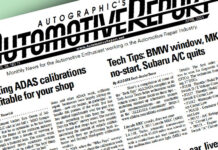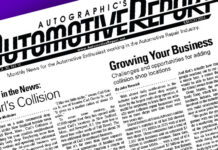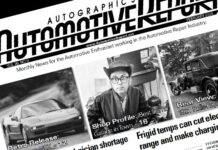Changes that the ‘Who Pays for What’ survey series has found – or influenced – in the industry
By John Yoswick
Trainer and consultant Mike Anderson’s idea wasn’t new, but his implementation of it has had some significant impact for the industry.
Back in 2015, Anderson of Collision Advice wanted to resurrect a type of report he remembered finding helpful years earlier when he still owned a pair of body shops in Virginia.
“For many years when I owned my shops, I looked forward to a report one of the industry publications produced that showed what not-included labor procedures shops were billing for, and which of the largest insurers were paying for those procedures,” Anderson said. “That publication was long gone in 2015, so I decided to take their basic idea and expand on it.”
Rather a single survey asking about a couple dozen labor procedures, Anderson worked with the industry publication CRASH Network (which this writer edits) to create four different quarterly surveys that in total would ask about billing and payment practices for about 100 not-included procedures and estimate line items.
“I knew if enough people participated, we could accomplish several things,” Anderson said. “Even just taking the surveys would serve as a reminder to those shops about the not-included items they were doing and could potentially be paid for. And the findings would help reassure shops that despite what they might be told, they aren’t ‘the only one’ charging for those items.”
Anderson’s first “Who Pays for What?” survey launched in April 2015, and industry interest in the project was immediately clear. More than 980 shops, from all 50 states, participated in that first survey, which focused on not-included refinish labor operations.
“I’ve talked to a lot of people who have done surveys in this industry over the decades, and no one has had anywhere close to that level of participation,” Anderson said. “We knew we’d tapped into something shops were hungry for.”
That appetite hasn’t diminished. Each survey since has received response from 650 to more than 1,000 shops, and a total of more than 4,000 shops have taken one or more of the quarterly surveys over the past five years.
The current quarterly survey — the 21st one that Collision Advice and CRASH Network have conducted — is open through the end of April. Shops can take it at www.crashnetwork.com/collisionadvice.
What have been some of the changes the surveys have found — or contributed to — over that time? Here’s some of what Anderson points to.
Billing, and regular payment, more common
For many of the procedures asked about in the surveys, a higher percentage of shops say they seeking payment when the procedure is necessary — and a higher percentage say they are being paid regularly. The not-included labor to match the OEM texture for chip, gravel, or stone guard is one example. In 2015, more than half of shops said this wasn’t a procedure for which they had billed, and among those that did, fewer than one in five said the largest insurers paid them “always” or “most of the time” for that procedure. By this year, however, a higher percentage of shops (59 percent) said they were billing for that labor, and among those shops, 43 percent said they were being paid always or most of the time.
Comparing five years of results from the third-quarter survey that each year examines about two dozen “not-included” frame and mechanical operations shows that, on average, 7 percent more shops are negotiating to be paid for the procedures, and an average of 8.5 percent more shops are reporting being paid “always” or “most of the time” for them compared to five years ago. Some operations, like draining fuel tanks, have changed little over the five surveys, with one-third of shops still not negotiating for that procedure; about two-thirds of those who do, report regularly being paid for it.
But the surveys also have found slow but steady improvement in billing and payment practices for several of the operations. In 2015, about 81 percent of shops said they were not negotiating to be paid for performing destructive test welds; that had dropped dramatically to just 52 percent in 2019.
Perhaps because performing post-repair test drives is becoming increasingly necessary (and complex) because of advanced driver assistance systems (ADAS), that is also being added to estimates at a higher rate than five years ago; nearly one in three shops now report being paid “always” or “most” of the time for such test drives, up from just 13 percent five years ago.
Although roughly the same percentage of shops as five years ago are seeking to be paid for “pre-diagnostic alignment,” shops’ success in getting paid for it has increased steadily over the five years. About 37 percent of shops in 2015 said they were paid for this step always or most of the time, but that had grown to 52 percent in the 2019 survey.
More than just labor items
The surveys ask about more than just estimate line items, helping gauge changes in shop perspectives over time as well. For example, the “Who Pays” survey last fall found that more shops are beginning to feel that the money and time invested in becoming OEM certified for aluminum repair is paying off. Overall, 37 percent of shops said they believe that becoming certified was a good or even great investment that is showing returns for their business, up from 28 percent in 2016. Although 19 percent of certified shops still feel the investment has not yet been worth it, in 2016 an even higher percentage of shops (29 percent) thought it was a “terrible” investment, or at least not a good one.
“’I see these results as a positive sign that shops are beginning to realize value from their OEM aluminum training and certification,” Anderson said.
The industry’s level of awareness and adoption of vehicle scanning over time can also be seen in the “Who Pays” survey results. Back in 2016, the surveys found that more than 30 percent of all shops said that one of the reasons they didn’t perform a post-repair vehicle scan was that insurers didn’t pay them for the procedure. Three years later, just 12 percent of shops say a lack of insurer payment is one of the reasons they might not perform a vehicle scan.
That change could in part be attributable to both shops and insurers being increasingly aware of the importance of vehicle scans. In 2019, just 11 percent of shops said they might skip a post-repair scan because no dash lights are lit — not a legitimate reason — but three years earlier, closer to half of all shops (44 percent) said that was a reason they might skip the scan.
Likewise, in 2016 about one in five shops said they didn’t perform scans because they didn’t have the necessary tools in-house. In last fall’s survey, just 2 percent used that as an excuse.
The surveys have found that a steadily rising percentage of repairers are going directly to the automakers’ websites to research needed OEM repair information. Five years ago, just 32 percent of repairers responding to the “Who Pays for What?” survey said they used the automaker websites to obtain repair information. That had nearly doubled to 59 percent in last fall’s survey.
That may suggest that repairers are doing a better job at researching the necessary OEM information before repairing the increasingly complex vehicles coming into their shops. But the surveys find there’s still much room for improvement, according Anderson.
“About 54 percent say they are researching procedures all or most of the time compared to about 42 percent five years ago,” Anderson said. “However, at the end of the day, this should still be done 100 percent of the time.”
Doing so can also provide repairers with another level of liability protection, according to Anderson.
“You need to research that information every time, and save it on file, so if you ever get audited for whatever reason, you can say, ‘The reason we did this procedure was because this is how the OEM said to do it at that time,’” Anderson said.
Raising shop awareness
Even more than billing and payment, education about things like researching OEM procedures is a key goal of the “Who Pays for What?” surveys, Anderson said. The reports detailing the survey findings include his insights into the need for the various procedures, along with links to various resources to help shops understand — and explain to insurers or customers — how the procedures fit into a complete and safe repair.
“It’s clear from these surveys that whether or not a shop is paid for a particular procedure depends to some degree on whether or not the shop negotiates for it,” Anderson said. “Though this can vary by insurance company, DRP status or region of the country, the surveys show that while none of the procedures asked about are universally paid for by insurers, none are universally rejected either. There are many examples in the surveys where nearly three out of four shops report getting paid all or most of the time for a certain procedure, yet another 20 or 30 percent of shops say they have never charged for it. That’s something we’re trying to change.” •
John Yoswick, a freelance writer based in Portland, Ore., who has been writing about the automotive industry since 1988, is also the editor of the weekly CRASH Network bulletin (www.CrashNetwork.com). He can be contacted by email at john@CrashNetwork.com.



